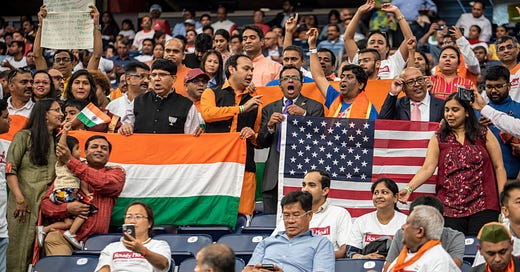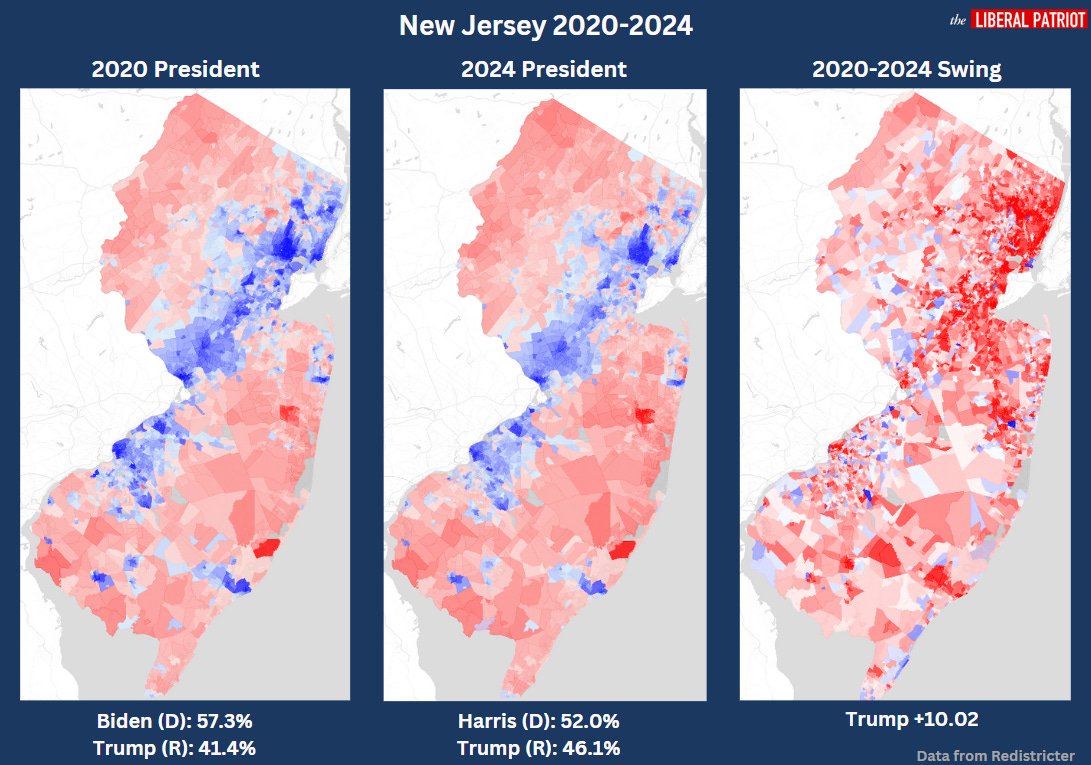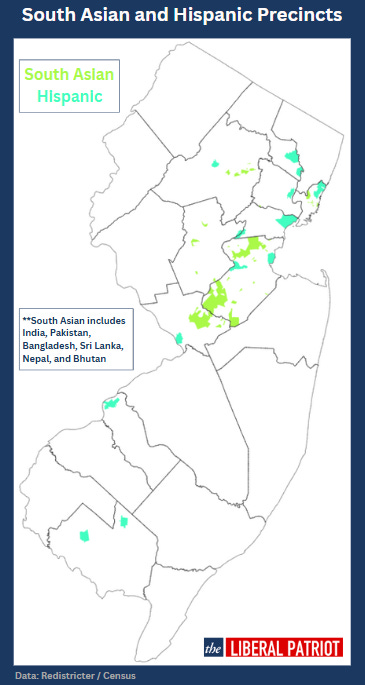Indian Americans Ditch Democrats
Precinct-level analysis shows Trump dramatically improved with South Asian voters in 2024.
Asian Americans have long leaned towards Democrats, an advantage that spanned education, gender, age, and nationality. As recently as 2023, strong majorities of Chinese, Filipino, Korean, and Indian voters identified with the Democratic Party; only Vietnamese voters leaned red. That dominance disappeared in November as Asian-American voters across the country raced towards Trump.
After Biden’s 41-point margin in 2020, Harris carried Asian voters by 30 points. Though less decisive in battleground states, this shift drove the sudden purpling of New York, New Jersey, and a slate of once-deep-blue congressional districts in California. But just as we should avoid treating black and Hispanic voters as a block—Cuban Americans in Miami are not Mexican Americans in El Paso, black voters from the Mississippi Delta are not black voters from the Bronx—Asian Americans, too, are not a monolith.
From Nikki Haley to Vivek Ramaswamy to Kamala Harris, the 2024 campaign featured an unprecedented number of high-profile Indian Americans. But there’s been surprisingly little analysis of how Indian Americans actually voted last fall. Much ink has been spilled about the overall rightward shift of Asian Americans, but there hasn’t been a strong effort to disaggregate the voting behavior of Indian Americans specifically.
This lack of analysis is, in part, because it is a frustrating task. Indian Americans are a smaller and more diffuse group—the latest estimates suggest there are about 2.6 million eligible Indian-American voters spread across the fifty states. While we might generate strong estimates for certain black or Hispanic populations by summing a string of counties, analysis of Indian Americans requires more precision.
But it is also a worthwhile effort. Indian Americans are increasingly electorally important. Between 2010 and 2020, the Indian American population increased by a whopping 50 percent nationwide. Growth has been particularly pronounced in Georgia and Texas—two states that will hold outsized influence in the next decade of presidential politics. Surveys find that Indian Americans are very high-propensity voters and the community’s high median income makes for a ripe target for political donations. There’s also a twist specific to 2024: research suggests Indian Americans are “especially inclined to mobilize behind candidates who share their ethnicity.” In short: a group worth studying.
So, what does the data say? To build a portrait of Indian-American voting patterns, we’ll use New Jersey, home to one of the largest concentrations of Indian Americans.
Using 2020 census data, I selected every majority-Asian precinct and subsequently filtered for areas where the Asian population was majority South Asian (to exclude, for example, Korean neighborhoods in Fort Lee). The result is a smattering of precincts across North and Central Jersey centered on Middlesex and Mercer counties. The “district” holds 300,000 people and is 61 percent Asian. More than 70 percent of that Asian population is Indian.
Of course, these estimates are not perfect. To truly isolate the Indian American population, even at the precinct level, is impossible. The selected precincts are still about a quarter white and some of the Asian voters included are Chinese, Filipino, or any number of other nationalities. Nevertheless, the district is certainly plurality Indian American and we can make reasonable inferences about the 2024 election. In the map below, Indian American precincts are shown in green. For comparison, New Jersey’s most Hispanic areas are shown in blue.
In 2020, Indian-American precincts voted for Joe Biden by 42 points. Four years later, Harris won them by only 26 points—a sixteen point swing towards Trump. Though some activists continue to claim otherwise, this shift is not solely a product of Democratic disinterest: Trump earned thousands more votes this time around.
The shifts in Hispanic areas, particularly those closest to New York City, were even more staggering. The blue precincts, which hold nearly a million people, swung towards Trump by 26 points. If we stretch back to Hillary Clinton’s 2016 numbers, an even more dire picture emerges. The working-class Hispanic city of Passaic, for example, favored Clinton by 52 points. Last year, it voted for Trump by 5 points.
Though the magnitude is startling, pro-Trump shifts among New Jersey Latinos dovetail with expected 2024 election narratives—non-white working-class voters dumping Democrats. Indian-American voters present a more confounding situation. The green precincts are more than 70 percent college educated and nearly four in ten have a post-graduate degree. The average household income exceeds $160,000. All these demographic factors point to a blue-trending area—these are places Democrats should be doing well. Instead they moved 16 points towards Trump. At least in these New Jersey towns, racial realignment appears to have trumped a class realignment in 2024.
To better understand the shift, I spoke with Priti Pandya-Patel, the chairwoman of the New Jersey GOP’s South Asian Coalition. As immigrants grow more familiar with the Republican Party, she told me, some have realized the GOP’s platform simply better aligns with their conservative values. Survey data backs up her claim: third-generation (or higher) Asian immigrants are much more Republican than their second-generation counterparts.
But, like most of the country, rightwards shifts among Indian Americans are best explained by immigration and inflation. The immigration issue might be particularly salient: “Most of us came here legally, and now you see all these people here illegally,” Pandya-Patel said, “It doesn’t matter their nationality, they just didn’t come here the right way.”
Whether Trump and the GOP can hold onto these new voters is another question. His birthright citizenship executive order, which would disproportionately impact Indian Americans, polls terribly with the general public. AP/NORC and Ipsos/Reuters both find the order underwater by 23 points—and the numbers are likely much worse with Asian Americans. Furthermore, if the MAGA movement decides to pick a fight over H1B visas, Indian Americans, who have long benefited from these immigration pathways, could snap leftwards.
No matter Trump’s early antics, however, the 2024 election showed Indian Americans are not nearly as Democratic as they once were. With their electoral influence bound to grow, both parties must respond accordingly.








Agree with this analysis. Most south Asians are culturally conservative. They are hard working and pay taxes. Often they are working hard to earn $20 or $30 an hour. They see huge numbers of illegals coming into American cities and receiving government money, free housing, free healthcare in some states, publica education for their non English speaking children. This doesn't make sense to anyone besides Democrat strategists who believed that more immigration would create more democrat voters. Oops.
Well, I have been ahead of these arguments for almost a year now, stating in June that Trump would win 312 EVs, win the popular vote, etc. At the time, I was looking mostly at voter reg statistics---as you mostly do here with Indian Americans.
I have shifted a little to real-world MASSIVE demographic change, i.e., VA is losing thousands upon thousands of Democrats---if not now, within the year. The DOGE firings are absolutely ripping through DC and are seen in the home offerings, which are up DOUBLE over the previous month, the Google searches for "layers" "bleachbit," "offshore banks," and the like. No, this is NOT an urban legend. Home prices in the Fairfax/southern MD area are already down a median of $139,000. By the time all of these fired former fed employees leave, VA will be an absolute tossup state to go along with NJ and NH.
But there's more bad news for Democrats: the so-far slow round up of illegals and deportations will accelerate. When it does, TENS of thousands of Democrat "voters" are going to disappear. It's almost like the angel of death sweeping through Egypt, taking only one group and leaving the other. But this is what happens when a party becomes extremely reliant on fed employees and illegals as core elements of their voter constituency.
If the economy improves at all, which it will merely by the introduction of the Trump energy policies, 2026 could be a serious bloodbath for Democrats.